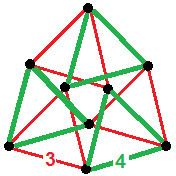 | ||
In four-dimensional Euclidean geometry, the birectified 16-cell honeycomb (or runcic tesseractic honeycomb) is a uniform space-filling tessellation (or honeycomb) in Euclidean 4-space.
Contents
Symmetry constructions
There are 3 different symmetry constructions, all with 3-3 duoprism vertex figures. The
Related honeycombs
The [3,4,3,3], , Coxeter group generates 31 permutations of uniform tessellations, 28 are unique in this family and ten are shared in the [4,3,3,4] and [4,3,31,1] families. The alternation (13) is also repeated in other families.
The [4,3,31,1], , Coxeter group generates 31 permutations of uniform tessellations, 23 with distinct symmetry and 4 with distinct geometry. There are two alternated forms: the alternations (19) and (24) have the same geometry as the 16-cell honeycomb and snub 24-cell honeycomb respectively.
There are ten uniform honeycombs constructed by the
The ten permutations are listed with its highest extended symmetry relation:
